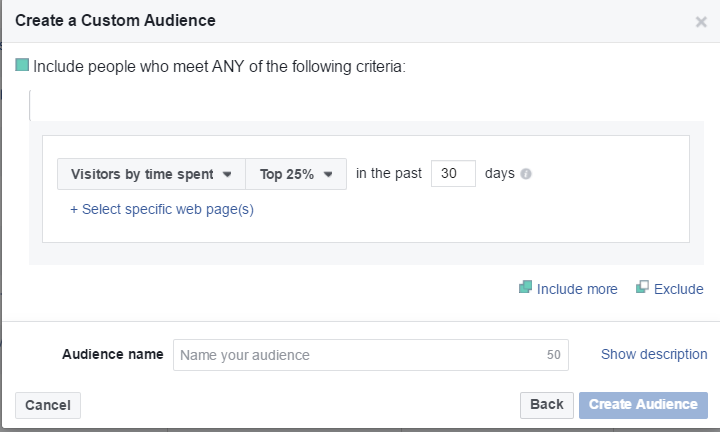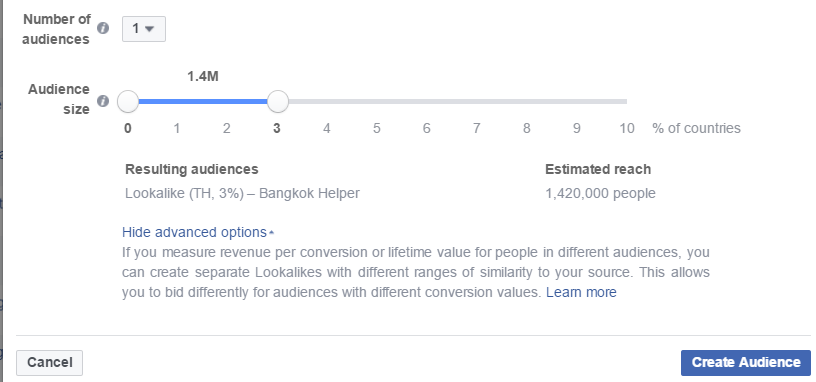To scale any Facebook funnel you’ll need to ensure you can target as many relevant prospects at the top. The more people who enter your funnel, the more customers you’ll end up with.
A lookalike audience is an audience on Facebook that has been gathered from any of the following:
- Customer list
- Page
- Website custom audience
- App users
- Engagement custom audience
Facebook uses these datasets to create lookalike audiences of millions of similar users that you can start targeting at the top of your funnel.
Number of people needed to make a lookalike audience
At a minimum, you need 100 datasets (100 users) to be able to create a lookalike audience from any of the datasets in the bullet points above.
After years of working with lookalike audiences, I believe you need at least 1,000 emails to create an effective lookalike audience, and more than 5,000 fans or page engagements to create an accurate audience based on your page or post engagements.
Think of it this way: the cheaper the dataset, the more people you need and the less profitable it will be.
For example, a dataset of 1,500 emails of customers who have made a transaction with your business is going to be much stronger than an email list of 3,000 people who have signed up to your newsletter but not performed a transaction.
Emails and standard event website custom audiences that are tied in with a conversion (sale, sign up, etc.) are what I like to call expensive datasets. They are harder to obtain, but the quality of users inside these datasets will help you to create better targeted lookalike audiences.
Cheap datasets are post engagements, page likes, and website visitors. The reason they are ‘cheap’ is because they have not performed any intended action, and many of them might not even be interested in your product or service.
Liking a page post requires much less commitment and takes less time than visiting your store and buying a product. Creating a lookalike audience around page likes or engagements may not be as profitable, but many marketers tend to use these sources as they contain more datasets.
Focus on your expensive datasets first
If you have a huge amount of emails, then instead of grouping them all together, focus on your most ‘expensive emails’ first (i.e. your customers). Based on your list size, you might even want to segment your customers into various categories and create lookalike audiences for each group.
For example, if you’re selling a SaaS tool to individuals and business owners, then assuming you have enough emails from each segment (1,000+), I would go and create two lookalike audiences for each customer profile.
One for individuals.
One for business owners.
Then I’d go ahead and serve each group with a personalized ad message to drive traffic to the top of my funnel.
If you don’t have enough emails to create a custom audience, then the next best thing is website visitors. Instead of targeting all website visitors, create segments from people who visited specific pages such as products or pages that require two or more clicks to reach, as this shows greater intent.
You can take things one step further by targeting the top 25% of your website visitors and creating a lookalike audience around them.

Combine this with interest targeting to weed out weaker users who may not be ideal for your product or service.
Audience size
When creating a lookalike audience, Facebook will ask you to select a percentage from 1-10% of how many people you want in your audience. The higher the percentage, the more people in your audience but the less targeted it will be.
If you’re working with huge daily budgets and want to scale already profitable campaigns, you’ll want to go into the 5-8% range. If you have a limited budget I think 2-4% is fine and is what most businesses should be using.

Facebook lets you create multiple audiences at one time, so I suggest making a few and testing them to see what segment performs best.
Summary
To scale a Facebook funnel the users entering your funnel need to be targeted. If you start driving thousands of poorly targeted users into the top of your funnel, then as they fill up your website custom audiences and email lists you’ll be leaking money in ad spend at each stage of your funnel.
How are you currently using lookalike audiences to grow your business, and are you making any of the mistakes listed in this article?